

Manipulation of Atomic-Scale Skyrmions with Spin-Polarized Surface Currents
I'm hiring. Starting on 2025-04-01, a new PhD position at the University of Hamburg (Germany) will open to tackle the question on how to manipulate atomic-scale skyrmions with spin-polarized surface currents, utilizing SP-STM in a novel three-tip experimental setup. Interested to do your PhD in this fascinating field of nanoscience? Feel free to contact me for more information!
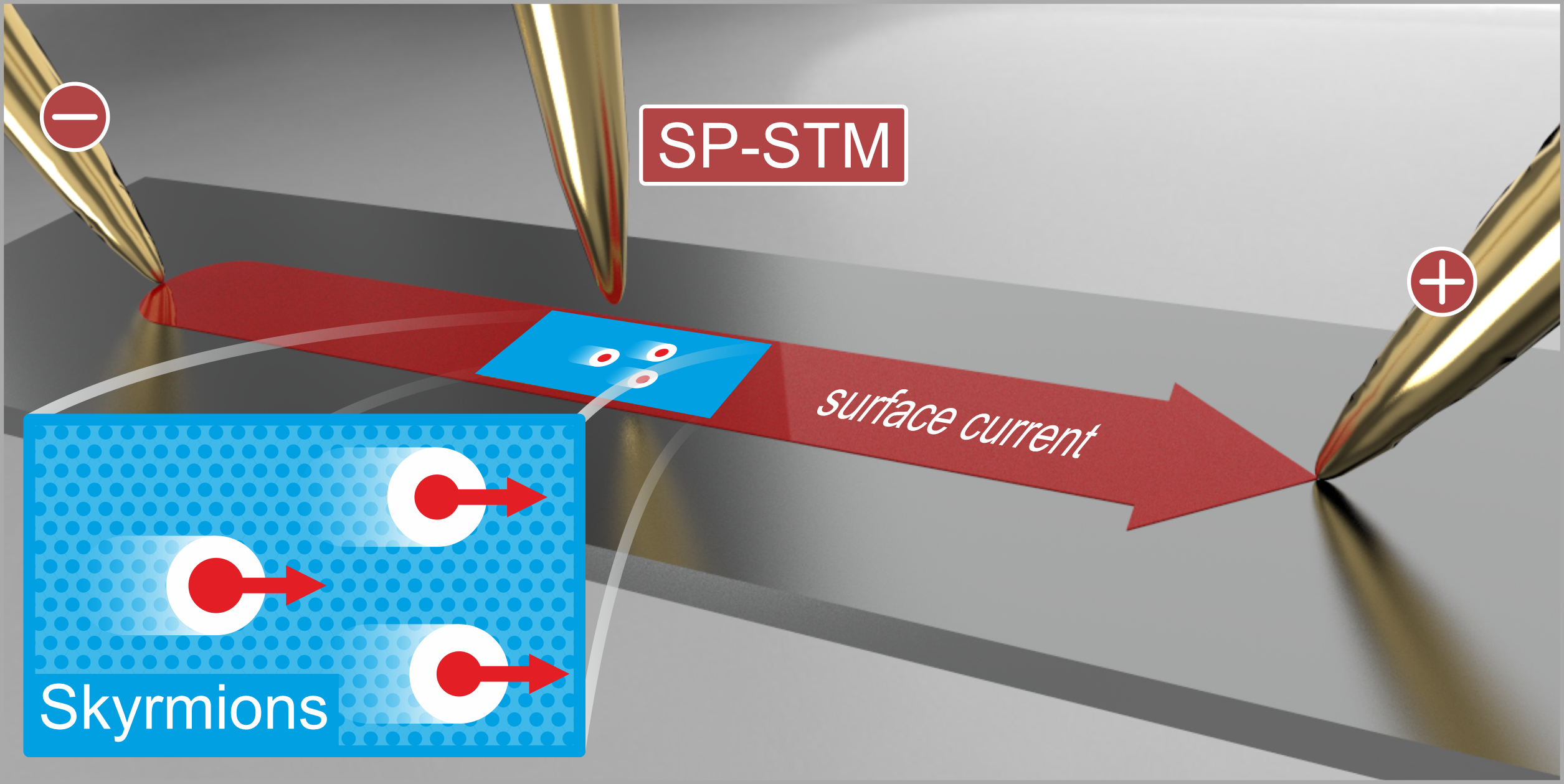
Details and application:
www.uni-hamburg.de
New paper publication in the Surf. Sci. special issue "60 years of Surface Science: Achievements and Perspectives"
The growth of Fe on a clean Be(0001) surface is investigated on the atomic scale by a combined scanning tunneling microscopy and density functional theory study. At low Fe coverage, the nucleation of terraced nanoislands with a disordered surface is observed experimentally. Increasing the Fe coverage results in the growth of extended films exhibiting a well-ordered p(2x2) superstructure. Density functional theory is applied to investigate the growth of Fe on a Be(0001) surface from individual atoms to extended films. Our studies provide strong evidence for the formation of a buckled honeycomb Fe lattice that is embedded in two Be planes with Kagome and triangular symmetry, respectively.
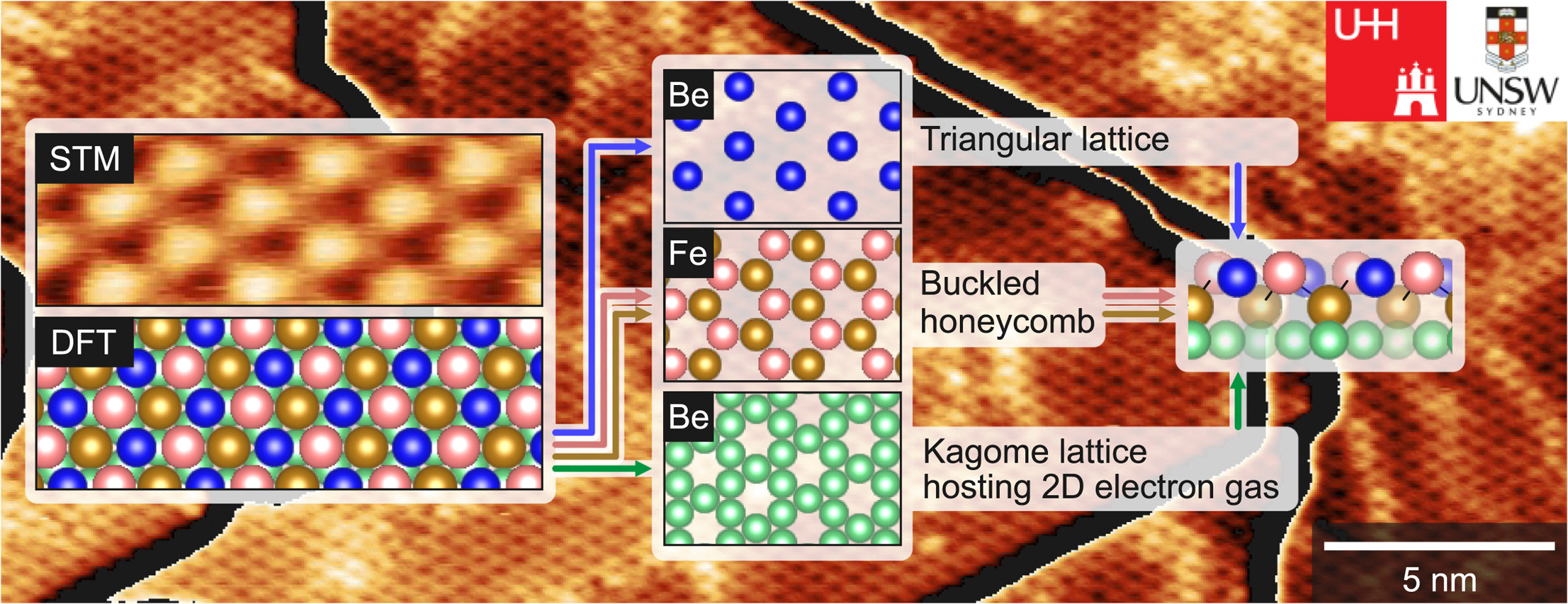
H. Osterhage, A. H. Khan, K. Oetker, R. Dao, S. Setayandeh, R. Wiesendanger, P. Burr, and S. Krause
Surf. Sci. 752, 122609 (2025)
DOI
Developing atomic-scale circuits based on carbon nanotubes for future devices
I am happy to be part of the new "3D-BRICKS" project that just started. It will be an exciting collaboration, bringing together various expertise from all the partners. The main goal is the development of atomic-scale logic circuits built from carbon nanotubes that self-assemble with the help of DNA origami techniques. We in Hamburg will use our new three-tip STM setup to characterize the devices and perform transport measurements, thereby providing insights to the atomic-scale physics on the performance of the devices.
Project website:
3d-bricks.eu
New paper publication in Phys. Rev. B
Beryllium is a very unique element in the periodic table: Although the bulk is almost insulating, the surface is conductive. We investigate this electronic surface state by means of scanning tunneling microscopy, revealing pronounced patterns of bias-dependent standing waves. Fourier analysis reveals a parabolic dispersive behavior, being characteristic for a two-dimensional free-electron gas confined to the Be(0001) surface. Moreover, signatures of the opening of inelastic phonon-mediated tunnel channels for electrons near the Fermi level are observed by STS.
H. Osterhage, R. Wiesendanger, S. Krause
Phys. Rev. B 103, 155428 (2021)
DOI
Pre-print uploaded by R. Wiesendanger
Accompanied by an official press release of the University of Hamburg, Prof. R. Wiesendanger published a not peer-reviewed investigation on the potential origin of the ongoing coronavirus pandemic. Although I am a research assistent of his group, I was by no means involved in the work.
My scientific focus remains directed onto the exciting world of nanomagnetism down to the single atom limit. Utilizing state-of-the-art experimental approaches that are suitable to answer questions about the fundamental physics involved in static and dynamic atomic-scale magnetism, I am addicted to this special field of research.
At the moment the entire human race is facing a severe pandemic. I feel with all the people who are currently suffering in numerous ways from this catastrophe. My highest respect to all the nursing assistants, doctors and scientists who are fighting hard to bring all of us back into a better state.
Stefan Krause, 2021-02-19
New paper publication in Phys. Rev. B
The role of impurity clusters for the current-driven motion of magnetic skyrmions in a racetrack geometry is investigated by a theoretical study numerically solving the Landau-Lifshitz-Gilbert equation. Non-conducting as well as magnetic impurities are considered. Whereas the non-conducting species affects the otherwise homogeneous current distribution in the racetrack, it is not altered for magnetic impurities. Four different scenarios of Skyrmion motions are observed in the presence of disorder, the skyrmion decay, the pinning, the creation of additional skyrmions, and ordinary skyrmion passage. We calculate and discuss phase diagrams in the dependence of the impurity concentration and radii of the impurities.
M. Stier, R. Strobel, S. Krause, W. Häusler, and M. Thorwart
Phys. Rev. B 103, 054420 (2021)
DOI
Real-space imaging of atomic-scale spin textures at nanometer distances
Spin-polarized scanning tunneling microscopy (SP-STM) experiments on ultrathin films with non-collinear spin textures demonstrate that resonant tunneling allows for atomic-scale spin-sensitive imaging in real space at tip-sample distances of up to 8 nm. Spin-polarized resonance states evolving between the foremost atom of a magnetic probe tip and the opposed magnetic surface atom are found to provide a loophole from the hitherto existing dilemma of losing spatial resolution when increasing the tip-sample distance in a scanning probe setup. Bias-dependent series of SP-STM images recorded via resonant tunneling reveal spin sensitivity at resonance conditions, indicating that the spin-polarized resonance states act as mediators for the spin contrast across the nm-spaced vacuum gap. With technically feasible distances in the nm regime, resonant tunneling in SP-STM qualifies for a spin-sensitive read-write technique with ultimate lateral resolution in future spintronic applications.
The article is highlighted as an Editors pick and by an AIP SciLight article: "Atomic-scale spin textures safely imaged at nanometer distances".
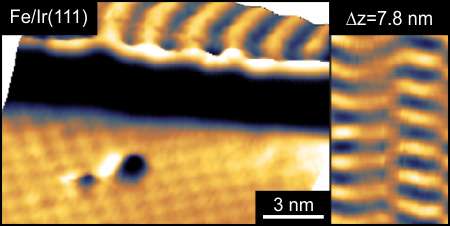
A. Schlenhoff, S. Kovarik, S. Krause, and R. Wiesendanger
Appl. Phys. Lett. 116, 122406 (2020)
DOI
Vacuum resonance states as atomic-scale probes of noncollinear surface magnetism
We experimentally realized a spin-resolved electron interferometer on the atomic scale by placing an atomically sharp magnetic probe tip in front of a magnetic sample surface and realizing a one-dimensional trap for electrons in the gap. Only when resonance conditions in terms of electron energy and spin are fulfilled, standing wave states evolve in the trap, and injection of spin-polarized electrons into these states allows for the investigation of single electron reflection at the underlying atom at the surface. Providing unprecedented insights into the atomic-scale scattering mechanism, the study potentially paves the way towards future spintronic devices employing spin-dependent electron scattering and transport.
Links:
Press release (from www.nanoscience.de)
Original article in Phys. Rev. Lett.

A. Schlenhoff, S. Kovarik, S. Krause, and R. Wiesendanger
Phys. Rev. Lett. 123, 087202 (2019)
DOI
Step-Edge-Induced Anisotropic Chiral Spin Coupling in Ultrathin Magnetic Films
Step edges represent a local break of lateral symmetry in ultrathin magnetic films. In our experiments, we investigate the spin coupling across atomic step edges on Fe/W(110) by means of spin-polarized scanning tunneling microscopy and spectroscopy. Local modifications of the spin texture toward step edges separating double from single layer areas are observed, and selection rules indicate a chiral spin coupling that significantly changes with the propagation along the [1-10] or the [001] crystallographic direction. The findings are explained via anisotropic Dzyaloshinskii-Moriya interactions arising from the broken lateral symmetry at atomic step edges.
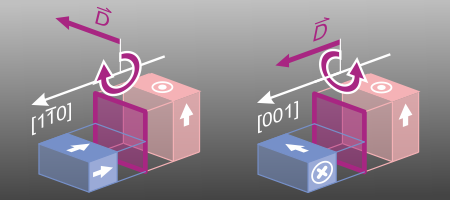
A. Schlenhoff, S. Krause, and R. Wiesendanger
Phys. Rev. Lett. 123, 037201 (2019)
DOI
Magneto-Seebeck Tunneling on the Atomic Scale
A thermo-sensor for magnetic bits - a new concept for energy-efficient data processing technology. We detected the magnetic states of atoms on a surface using only heat. The respective study is published in the recent volume of the “Science” magazine.
A magnetic needle was heated by a laser beam and approached to within close proximity of a magnetic surface, with a gap of only a few atoms width. The temperature difference between the needle and the surface generates an electric voltage. Scanning the needle across the surface, the scientists succeeded in showing that this thermovoltage depends on the magnetic orientation of the individual atom below the needle.
Links:
Press release (from www.nanoscience.de)
Original article in Science
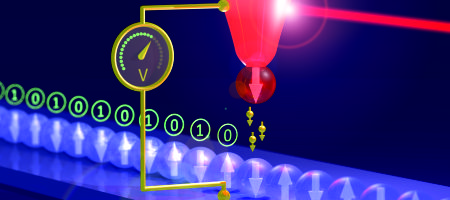
C. Friesen, H. Osterhage, J. Friedlein, A. Schlenhoff, R. Wiesendanger, and S. Krause
Science 363, 1065 (2019)
DOI
On the occasion of the "Nacht des Wissens" (public night of science), I will give an overview oral presentation about what you can learn from analyzing the telegraphic noise recorded on superparamagnetic nanomagnets:
Telegramme aus der Nanowelt: Was die Atome uns erzählen (in German) Details
Sat, 2017-11-04, 21:00-21:45, Department of Physics, Lecture Hall INF, Jungiusstrasse 11A, Hamburg
More detailed information on the "Nacht des Wissens", including the full propramme of all contributing scientific institutions in Hamburg, can be found here:
nachtdeswissens.hamburg.de
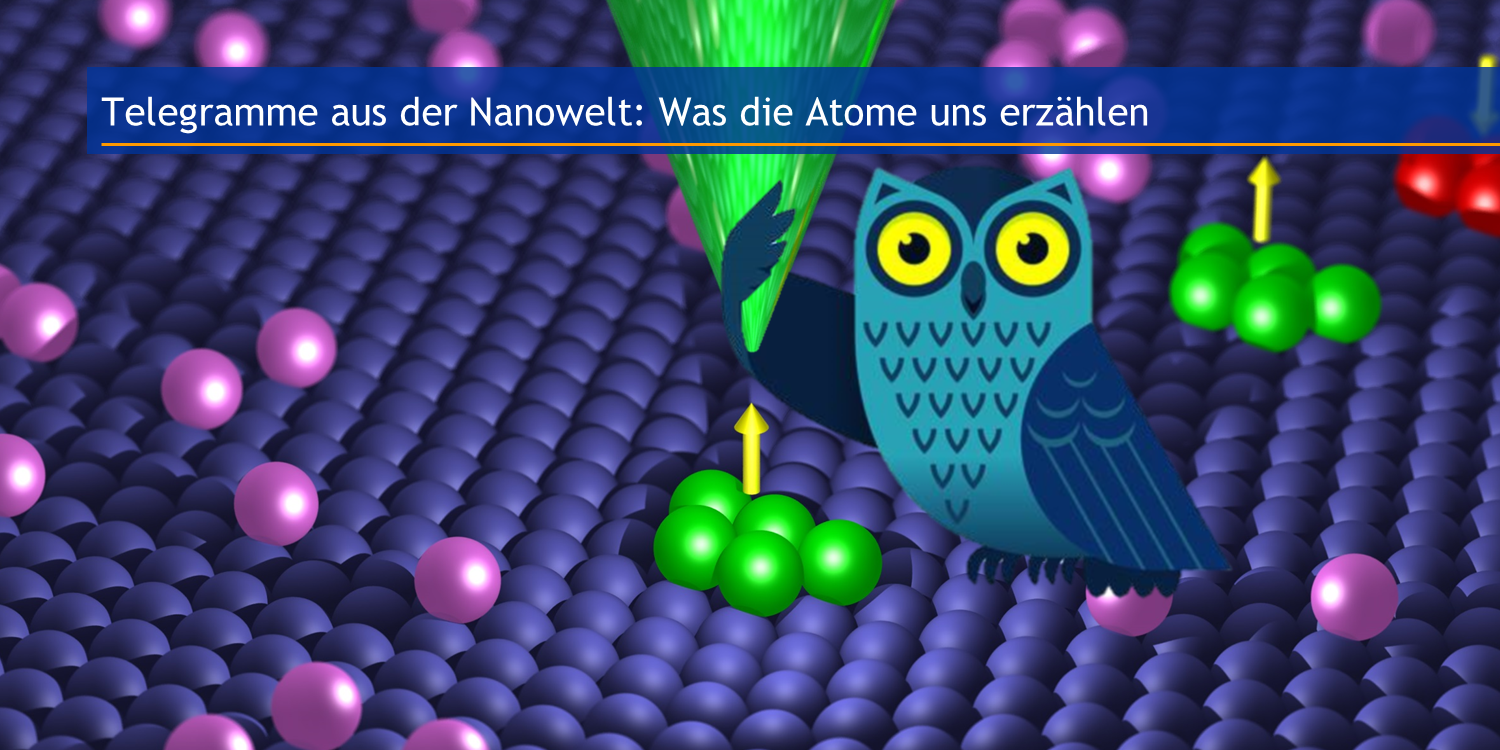
You are attending the 61st Annual Conference on Magnetism and Magnetic Materials (MMM)? Please feel free to join my presentation, focussing on our most recent research:
Thu, 2016-11-03, 8:54-9:06, EC-03, Room La Galeries 1-2
High Frequency Magnetization Dynamics of Individual Atomic-Scale Magnets
S. Krause, A. Sonntag, J. Hermenau, J. Friedlein, and R. Wiesendanger
You are attending the International Conference on Nanoscience and Technology (ICN+T) in Busan (South Korea)? Or the SPSTM-6 in Chiba (Japan)? Please feel free to join one of my presentations, focussing on our most recent research:
ICN+T: Tue, 2016-08-23, 12:15-12:30, NS-05-2-O-TU (oral presentation), Room 102
High Frequency Magnetization Dynamics of Individual Atomic-Scale Magnets
S. Krause, A. Sonntag, J. Hermenau, J. Friedlein, and R. Wiesendanger
ICN+T: Tue, 2016-08-23, 14:45-15:00, NS-06-3-O-TU (oral presentation), Room 102
A Magnetic Nano-Skyrmion Lattice Observed in a Si-Wafer Based Multilayer System
A. Schlenhoff, P. Lindner, J. Friedlein, S. Krause, R. Wiesendanger, M. Weinl, M. Schreck, and M. Albrecht
SPSTM-6: Tue, 2016-08-30, 9:20-10:00 (Invited Talk)
High Frequency Magnetization Dynamics of Individual Atomic-Scale Magnets
S. Krause
On the occasion of the "Nacht des Wissens" (public night of science), I will give an overview oral presentation about what you can learn from analyzing the telegraphic noise recorded on superparamagnetic nanomagnets:
Telegramme aus der Nanowelt: Was die Atome uns erzählen (in German)
Sat, 2015-11-07, 22:00-22:30, Department of Physics, Lecture Hall INF, Jungiusstrasse 11A, Hamburg
More detailed information on the "Nacht des Wissens", including the full propramme of all contributing scientific institutions in Hamburg, can be found here:
nachtdeswissens.hamburg.de

On the occasion of the re-opening of the nano-exhibtion "Nanotechnologie: Aufbruch in neue Welten", I will give a public talk at the Physics Institutes on the campus Jungiusstraße in Hamburg:
Telegramme aus der Nanowelt: Magnetisierungsdynamik auf atomarer Skala (in German)
Fri, 2015-09-18, 15:00-15:30 + Sat, 2015-09-19, 15:00-15:30
More detailed information on the re-opening event can be found here:
www.nanotechnologie-ausstellung.de
If you plan to attend the International Conference on Magnetism (ICM-20) in Barcelona, please feel free to join one of my presentations, focussing on our most recent research:
Wed, 2015-07-08, 12:00-12:15, WE.G2_O2 (oral presentation), Room B1-B3
Electric-Field-Induced Magnetic Anisotropy in a Nanomagnet Investigated on the Atomic Scale
J. P. Hermenau, A. Sonntag, A. Schlenhoff, J. Friedlein, S. Krause, and R. Wiesendanger
Fri, 2015-07-10, 14:30-16:00, FR.H-P08 (poster presentation), Exhibition Hall
Thermal Stability of an Interface-Stabilized Skyrmion Lattice
S. Krause, A. Sonntag, J. Hermenau, and R. Wiesendanger
Fri, 2015-07-10, 17:15-17:30, FR.I.3_O1 (oral presentation), Room D4-D6
A Magnetic Nano-Skyrmion Lattice Observed in a Si-Wafer Based Multilayer System
S. Krause, A. Schlenhoff, P. Lindner, J. Friedlein, R. Wiesendanger, M. Weinl, M. Schreck, and M. Albrecht
Magnetic Nano-skyrmion Lattice Observed in a Si-Wafer-Based Multilayer System
Growth, electronic properties, and magnetic properties of an Fe monolayer (ML) on an Ir/YSZ/Si(111) multilayer system have been studied using spin-polarized scanning tunneling microscopy. Our experiments reveal a magnetic nano-skyrmion lattice, which is fully equivalent to the magnetic ground state that has previously been observed for the Fe ML on Ir(111) bulk single crystals. In addition, the experiments indicate that the interface-stabilized skyrmion lattice is robust against local atomic lattice distortions induced by multilayer preparation.
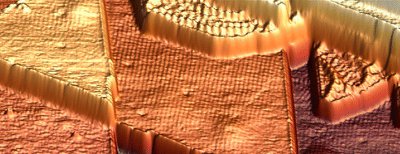
A. Schlenhoff, P. Lindner, J. Friedlein, S. Krause, R. Wiesendanger, M. Weinl, M. Schreck, and M. Albrecht
ACS Nano 9, 5908 (2015) DOIThermal Stability of an Interface-Stabilized Skyrmion Lattice
The thermal stability of the magnetic nano-skyrmion lattice in the monolayer Fe/Ir(111) is investigated using temperature dependent spin-polarized scanning tunneling microscopy. Our experiments show that the skyrmion lattice disappears at a temperature of Tc=27.8 K, indicating a loss of long-range magnetic order. At second-layer iron islands the lattice is pinned and local order persists at temperatures above Tc. The findings are explained in terms of the complex magnetic interactions involved in the formation of the skyrmion lattice.
Electric-Field-Induced Magnetic Anisotropy in a Nanomagnet Investigated on the Atomic Scale
Magnetoelectric coupling is studied using the electric field between the tip of a spin-polarized scanning tunneling microscope and a nanomagnet. Our experiments show that a negative (positive) electric field stabilizes (destabilizes) in-plane magnetization against thermal agitation, whereas it destabilizes (stabilizes) out-of-plane magnetization. We conclude that the electric field E induces a uniaxial anisotropy that favors in-plane magnetization for E<0 and out-of-plane magnetization for E>0. Our experiments demonstrate magnetic manipulation on the atomic scale without exploiting spin or charge currents.
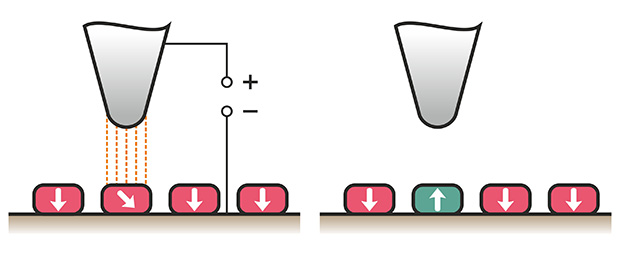
A. Sonntag, J. Hermenau, A. Schlenhoff, J. Friedlein, S. Krause, and R. Wiesendanger
Phys. Rev. Lett. 112, 017204 (2014) DOII am happy to announce that I will present an invited talk at the upcoming MMM conference in Denver, Colorado. The title will be "Current-Driven Spin Dynamics of Artificially Constructed Quantum Magnets", and I will summarize the main results from our recent Science paper.
Current-Driven Spin Dynamics of Artificially Constructed Quantum Magnets
As illustrated in the present volume of the magazine Science, we have constructed, atom-by-atom, the world’s smallest stable ferromagnet composed of only five iron atoms. These magnets can be utilized in future magnetic storage technology based on atomic spin elements using their special quantum properties.
The work clearly demonstrates how the different magnetic interactions can be controlled to design stable magnets which can be switched electrically. Moreover, this research, with its ultimate combination of spatial, magnetic, and temporal resolution of individual magnetic atoms, opens up the future for the ultimate miniaturization of spin-based technology down to the atomic scale.
Links:
Press release (from www.sfb668.de)
Original article in Science
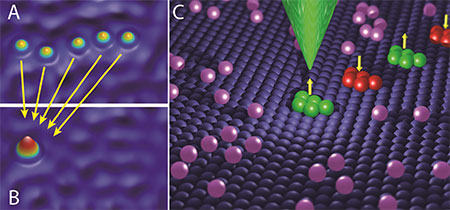
A. A. Khajetoorians, B. Baxevanis, C. Hübner, T. Schlenk, S. Krause, T. O. Wehling, S. Lounis, A. Lichtenstein, D. Pfannkuche,
J. Wiebe, and R. Wiesendanger
Science 339, 55 (2013)
DOI
Individual Atomic-Scale Magnets Interacting with Spin-Polarized Field-Emitted Electrons
We resonantly inject spin-polarized field-emitted electrons in thermally switching nanomagnets. A detailed lifetime analysis as a function of the spin-polarized emission current reveals that considerable Joule heating is generated, and spin-transfer torque results in a directed switching. A trend of higher switching efficiency per electron is observed with an increasing emission current, probably due to the excitation of Stoner modes. On a quasistable nanomagnet, a spin-polarized emission current in the low nA regime already triggers magnetization reversal, thereby demonstrating the high impact of hot-electron spins onto atomic-scale magnets.
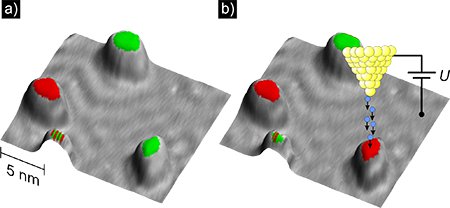
A. Schlenhoff, S. Krause, A., and Roland Wiesendanger:
Phys. Rev. Lett. 109,097602 (2012)
DOI